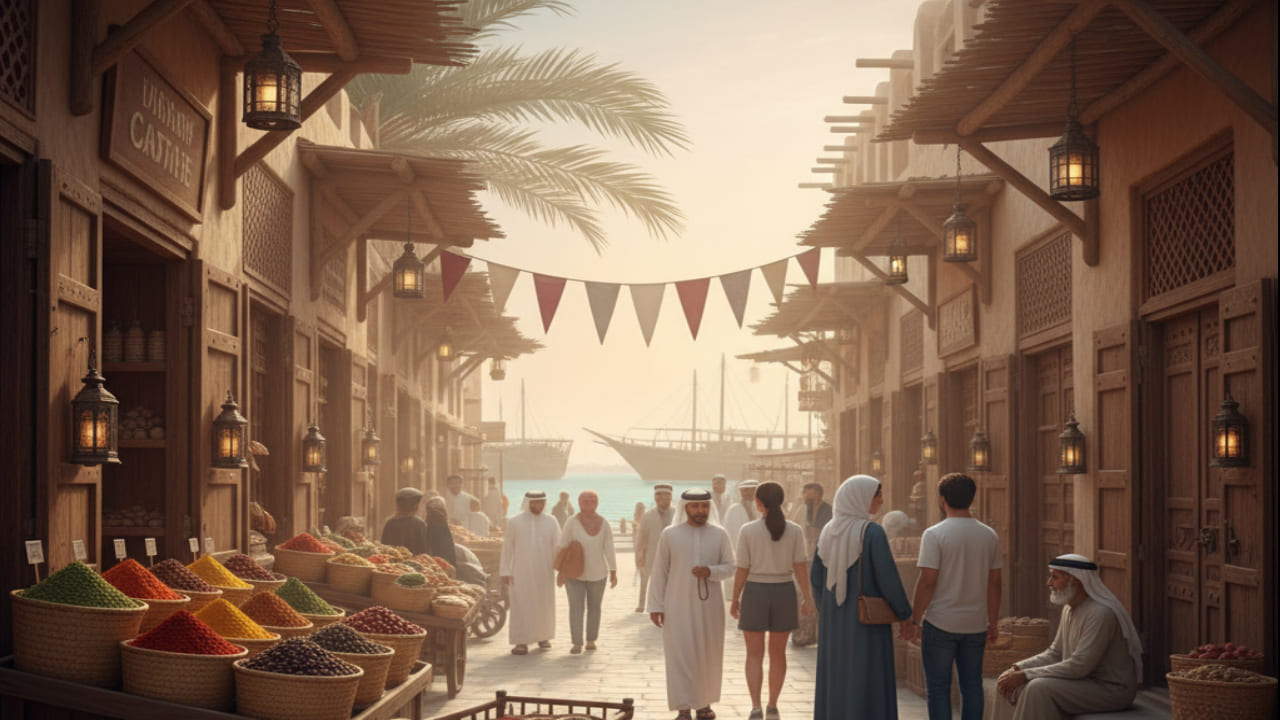Nestled along the southeastern coast of Qatar, just a short drive from Doha, Al Wakrah is a captivating blend of rich history and modern ambition. Once a humble fishing and pearling village, this thriving city—now the second-largest in Qatar—has transformed into a vibrant urban hub while preserving its cultural roots. With its picturesque beaches, bustling Al Wakrah Old Souq, and world-class landmarks like the Al Janoub Stadium, Al Wakrah offers something for everyone: families seeking relaxation, tourists craving authentic Qatari experiences, and sports fans eager to explore FIFA World Cup legacy sites.
History of Al Wakrah
Al Wakrah’s story begins centuries ago as a modest settlement founded around 1828, its economy rooted in fishing and pearling. The city’s name, derived from the Arabic word “wakar” (bird’s nest), reflects a nearby hill, Jebel Al Wakrah, known for hosting bird nests. Governed historically by Sheikh Abdulrahman bin Jassim Al Thani, it was a key pearling center, with 300 ships docked by 1920 and 250 boats noted in a 1925 British study.
Key Historical Moments
- 1828 Founding: Established by Ali bin Nasir of the Ajman tribe after a dispute with Bahraini rulers, Al Wakrah became Qatar’s first urban center.
- 1851 Battle of Mesaimeer: A significant conflict west of AlWakrah, marking its role in regional power struggles.
- 1866 Al Wakrah Incident: Bahraini forces arrested a Na’im tribe leader, sparking tensions resolved by Qatari leader Jassim bin Mohammed Al Thani.
- Modern Growth: Post-oil discovery, AlWakrah’s proximity to Mesaieed Industrial Area fueled its expansion, with milestones like the 2014 Souq AlWakrah opening and the 2019 Al Janoub Stadium inauguration.
Today, AlWakrah is a bustling city of over 299,000 residents (2015 census), evolving from a village into a modern hub while retaining its heritage.
Geography and Climate
AlWakrah Municipality spans 2,577.6 square kilometers, making it Qatar’s second-largest by area. Located 14 km south of Doha, it stretches along the Persian Gulf, with Doha to the north and Mesaieed to the south.
Landscape Features
According to the Ministry of Municipality and Environment, AlWakrah boasts:
- 192 depressions, 13 wadis, and 7 plains
- Jebel Al Wakrah, a 26-meter rocky hill 1.6 km south of the city
- Khor Al Adaid (Inland Sea), a UNESCO-recognized nature reserve in the southeast
- Two islands: Sheraouh and Al Aszhat
The southern region features sand dunes and elevations up to 60 meters, unlike Qatar’s flatter north.
Climate Overview
AlWakrah has a hot desert climate:
- Summer (June–August): Temperatures soar to 45°C (113°F) with high humidity.
- Winter (December–February): Milder at 15–25°C (59–77°F).
- Rainfall: Minimal, around 75 mm annually, mostly in winter.
Visitors should pack light clothing, sunscreen, and water shoes for rocky beaches.
Demographics and Culture
With a population of approximately 299,037 (2015), AlWakrah is a multicultural hub, hosting Qataris and expatriates from over 100 countries. Its cultural scene thrives on its pearling past and modern developments.
Cultural Highlights
- Traditional Practices: Fishing and dhow-building remain active, visible at AlWakrah Harbour.
- Festivals: Events like Qatar National Day feature traditional music, dance, and coffee ceremonies (karwa).
- Architecture: The souq’s restored houses and nine ancient mosques reflect Qatari heritage.
Economy and Infrastructure
AlWakrah’s economy has shifted from fishing and pearling to industry and tourism, driven by proximity to Mesaieed Industrial Area and Hamad Port.
Key Economic Drivers
- Industry: Home to Ras Abu Fontas power stations and Umm Al Houl’s desalination plants.
- Logistics: A 6.3 km² hub in Birkat Al Awamer supports Hamad Port.
- Tourism: Attractions like Souq Al Wakrah and Al Janoub Stadium draw millions.
Infrastructure includes the Doha Metro’s Red Line, connecting Al Wakrah to Doha in under 30 minutes.
Top Attractions in Al Wakrah
AlWakrah’s blend of heritage and modernity makes it a tourist favorite, with 1,869 TripAdvisor reviews praising its charm.
Must-Visit Sites
- Al Wakrah Old Souq: Opened in 2016, this 623,765 sqm market features traditional architecture, 415 restored houses, and a 1,237-meter beachfront promenade. Shop for spices, handicrafts, or dine at seafood restaurants like Al Noukhaza.
- Al Janoub Stadium: A 44,325-seat venue designed by Zaha Hadid, inspired by dhow sails, hosting Qatar Stars League matches.
- Al Wakrah Beach: Family-friendly with shallow waters, gazebos, and volleyball courts. Ideal for picnics and kitesurfing.
- Al Wakrah Public Garden: Home to 70+ plant species, perfect for walks and scavenger hunts.
- Ezdan Mall: A modern shopping hub with brands, a food court, and Fun Ville for kids.
Outdoor Activities
- Port Al Wakrah: Watch fishing dhows or try angling.
- Khor Al Adaid (Inland Sea): A UNESCO reserve for dune bashing and camping.
Living in Al Wakrah: Pros and Cons
AlWakrah is a popular residential choice due to its proximity to Doha and affordable housing.
Pros
- Affordable Housing: Villas and apartments range from QR 5,000–12,000/month.
- Connectivity: 15 minutes from Hamad International Airport via Ras Abu Abboud Expressway.
- Amenities: Schools like Podar Pearl and hospitals like AlWakrah Hospital.
- Family-Friendly: Safe beaches and parks.
Cons
- Limited Nightlife: Less vibrant than Doha for evening entertainment.
- Construction: Ongoing projects may cause noise.
Here’s a quick rental price table (2025 estimates):
| Property Type | Average Monthly Rent (QR) | Key Features |
|---|---|---|
| 1-Bedroom Apartment | 5,000–7,000 | Modern complexes, pools |
| 2-Bedroom Apartment | 7,000–9,000 | Family-friendly, balconies |
| Villa | 10,000–15,000 | Private yards, parking |
Sports and Entertainment
AlWakrah is home to AlWakrah Sports Club, founded in 1959, nicknamed “The Blue Waves.” They play at Saoud bin Abdulrahman Stadium and compete in the Qatar Stars League. The club’s next match is against Al Duhail on August 23, 2025.
FAQs
1. What is Al Wakrah known for?
AlWakrah is famous for its historic souq, family-friendly beaches, and Al Janoub Stadium, a 2022 FIFA World Cup venue.
2. How far is Al Wakrah from Doha?
It’s about 14 km, a 15–20-minute drive or 30-minute metro ride via the Red Line.
3. Is Al Wakrah good for families?
Yes, with safe beaches, parks, and schools like Podar Pearl, it’s ideal for family living.
4. What are the top attractions in Al Wakrah?
Key sites include Al Wakrah Old Souq, Al Wakrah Beach, Al Janoub Stadium, and Ezdan Mall.
5. How do I get to Al Wakrah from Doha?
Drive via Ras Abu Abboud Expressway or take the Doha Metro Red Line to Al Wakrah Station, then a Metrolink bus.

